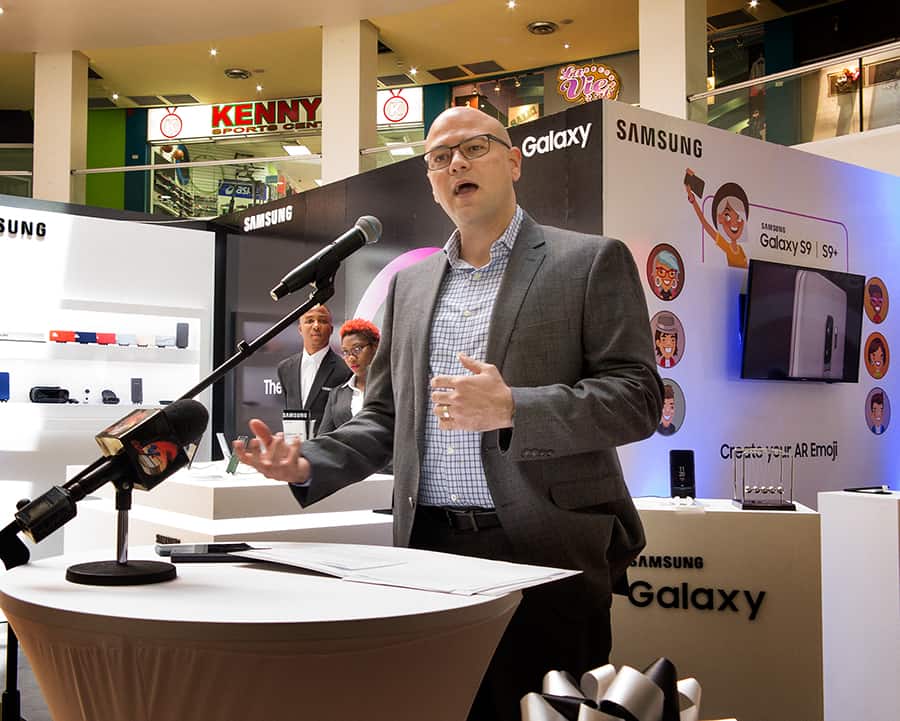
Above: Samsung’s Terry Weech introduces the S9 smartphone at Trincity Mall last Thursday. Photo by Mark Lyndersay.
Originally published in Newsday’s Business Day for April 12, 2018. This version includes reporting done for Newsday’s news pages on April 06, 2018.
Last Thursday, Samsung introduced the S9 and S9+ to the Trinidad and Tobago market.
This country, and the Caribbean region, have long been a proving ground for the company’s new smartphones, going all the way back to the original S phone, which didn’t carry a number.
The latest iteration of Samsung’s premium line of communications devices benefits from and is challenged by all that’s gone before.
The design of the phone, featuring a wrapped glass face that the company calls its Infinity Screen, reduces the bezel on the device to a thin line.
The software, couched in Samsung’s polished user interface for Android, is quick and intuitive, so the improvements over last year’s S8 end up being a little bit of catching up and a little bit of pushing ahead.
The new Augmented Reality Emoji come soon after Apple introduced a similar technology for its iPhones and the dual lens approach for improving photography in the cramped device was pioneered by Huawei with its P9 model.
Samsung is still improving its biometric authentication, and deeper integration with Knox is a welcome link with the company’s robust security layer.
Knox is embedded in both Bixby, the still maturing digital assistant and the new Smart Things rebrand, giving the company a robust foundation for seamless integration of its products via the Internet of Things (IoT) product which the company clearly sees as a strong future market.
Speaking at the launch of the S9 at Trincity Mall last week, Terry Weech, Samsung’s Mobile Innovations Manager for Latin America noted that the company had designed an excellent compact camera and built a phone around it.
That’s a fair assessment of the new device’s standout features, a new double aperture main lens with a market leading f1.5 maximum and a outdoors option of f2.4 and a SuperSloMo mode that captures video up to 720p at 960 frames per second.
Those are a lot of numbers to toss around at the average consumer, but for professional photographers and videographers, they are remarkable benchmarks to find in a camera of any kind; far less one that’s part of a premium smartphone.

Samsung Experience representative Jervon Thorpe (centre) gives a demonstration of the new S9 smartphone at the product’s local launch at Trincity Mall last Thursday. Photo by Mark Lyndersay.
Asked how the company would explain these advances to customers, Weech said, “That’s why we have experiences like these.”
“People question the difference between the S8 and S9 and here we have a chance to really get into the device and explain the new features.”
Samsung is placing an emphasis on having experienced brand representatives in retail who can take a user through the naunces of the improvements they have built into their newest devices.
“We know that the economy is not as strong as it was,” Weech said, “and we know that it isn’t a device for everyone, but we have high expectations for our premium products and the S9+ in particular has done very well since launch (globally in February).”
The next big thing to come for Samsung’s S9, and indeed all current Samsung technology products, is its Smart Things initiative.
Smart Things is Samsung’s vision for a world of interconnected devices which relay useful information to each other and gives users greater and more dynamic control over the electronic products they use every day.
Secured by Knox and with connections to open protocols for IoT devices, Smart Things is being positioned by Samsung as a user-friendly, secure and powerful way to usefully connect its household devices to smartphone control.
All current Samsung consumer products are Smart Things ready, and the company supports open protocols for connecting to other devices.
Albin Strothers, Product manager for Samsung Electronics, Latin America, explained in a recent interview that the company will deploy Smart Things connectivity for its devices in Puerto Rico, Panama and Guatemala by the end of this year or by the first quarter of 2019 at latest. Availability in the Caribbean region will follow.
Owners of the S7 Edge or S8 series smartphones won’t find much that’s different in the design, look and feel of the S9, but there’s a lot built into the phone for serious photographers and videographers and even more waiting when the company’s IoT digital infrastructure hits the region.
The S9 may be a bit of spit and polish in terms of design and colour schemes, a lot of meaningful improvements in image capture, but it’s also a stake in the ground for a future of digital omnipresence and control in the home as envisioned by Samsung.

